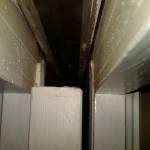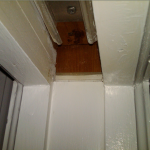Does anybody treat pocket doors in a standard pest control service? Are you passing up this huge void as you stalk spider infestations or scratching your head as you search the master bath for that American roach that just disappeared? The pocket door is a built in safe house that even a rat could love but I’m not sure many technicians really stop to investigate this ready made fortress let alone know how to treat it effectively without causing a mess.
While most voids are found under the sink where plumbing lines enter the walls or by removing wall switch plates, the pocket door void is HUGE and right there for easy access. For most wall voids we happily apply our dusts and it fills the void and will sit undisturbed and cause no trouble what so ever. If we dust in the pocket door however our dust is never settled and gets whipped up and some of it escapes every time we open or close the door, not good. Now I like most experienced bug guys have an excellent aim with my sprayer so a shot up one side and down the other might sound like a good idea but in reality you can only get just so much of the surface area with your spray and if any beads up on the door it can leave unsightly stains or streaking. That is of course unless you know how to do it right.
Tips on treating the pocket door
Using liquid
The easiest way I’ve found is using your pump sprayer set on fan spray but to avoid damaging the door you need to pull the door  closed and put your spray tip right against the door towards the top and as close to the opening as possible. There should be just enough room for you to squeeze a wide shot right in to the cavity. Instead of pivoting or dragging your nozzle after your quick hit, pull back and gently place the spray tip in the middle area of the door and spray again. Once more at the bottom and you should be good to go. Remember there are two sides of the door and hitting it from both may allow you to get places the other angle couldn’t. Don’t open the door while the spray is wet and dripping however, if you can use anther exit and get the other side or give it a few minutes and come back to finish up.
closed and put your spray tip right against the door towards the top and as close to the opening as possible. There should be just enough room for you to squeeze a wide shot right in to the cavity. Instead of pivoting or dragging your nozzle after your quick hit, pull back and gently place the spray tip in the middle area of the door and spray again. Once more at the bottom and you should be good to go. Remember there are two sides of the door and hitting it from both may allow you to get places the other angle couldn’t. Don’t open the door while the spray is wet and dripping however, if you can use anther exit and get the other side or give it a few minutes and come back to finish up.
Using dusts
The only insecticidal dust I use on a pocket door is aerosol products such as Borid Turbo. As stated above loose dusts such as from your puffer will become airborne as the door pushes the air in and out each time you use it. Aerosol dusts however stick to the surfaces it lands on like spray paint eliminating that problem. To use this approach you should have a straw tip on your dispenser cap and with the door closed, stick the tip into the void and spray. No need to hose the thing, just start at the top and move the can down the length of the void keeping the tip past the door the whole time. Give this treatment a few minutes to settle down before opening and being that this will float somewhat you shouldn’t have to hit both sides.
Using aerosols
 If you can’t find a product like Borid Turbo you can always use a standard aerosol that has the straw tip. Simply treat the door the same way as above but keep in mind that some spray cans are designed to come out as a stream type spray so you may need to hit both sides of the door and be extra careful as this thick spray can really ruin the finish of a pocket door. Flushing aerosols work best since they dispense like a fogger would but generally have little residual so you may need to retreat more often.
If you can’t find a product like Borid Turbo you can always use a standard aerosol that has the straw tip. Simply treat the door the same way as above but keep in mind that some spray cans are designed to come out as a stream type spray so you may need to hit both sides of the door and be extra careful as this thick spray can really ruin the finish of a pocket door. Flushing aerosols work best since they dispense like a fogger would but generally have little residual so you may need to retreat more often.
Using baits
Baits are an alternative you can use but are difficult to place. Gel baits in a syringe will show with the door open but you may be able to put some on the guide rails on the top or bottom. A better option is a granular bait such as Niban that you can squeeze in much like dusts using a bulb duster. The drawbacks of baits are pests such as spiders will be unaffected and rebaiting with granules or gels may build up on guide wheels causing the door to stick.
While a pocket door saves on average about 10 square feet of living space over a traditional swing door it creates a virtual castle for spiders, roaches and any number of pests. As you can see there are a couple of ways you can treat one of the largest and easiest voids you’ll find in any home. Some houses may have quite a few of these space saving doorways while others may only have one or two but now you’ll know how to break down these castle walls and keep the bugs out.




